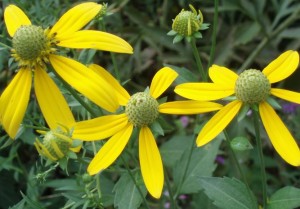Cutleaf Coneflower – October 2016 Wildflower of the Month
A valuable addition to the wild garden, Green-headed Coneflower typically grows 5-8 feet tall with bright yellow flowers that can be five inches across. This daisy-like flower with drooping rays has green center cones that are unusual in this genus of the Black-eyed and Brown-eyed Susans.
The leaves of these three common members of the aster family are different – Black-eyed Susans (Rudbeckia hirta) have oval, hairy and coarsely toothed leaves, and the leaves of Brown-eyed Susans (Rudbeckia triloba)are oval, not hairy and usually the lower leaves have three lobes. The leaves of Cut-leaf Coneflower leaves are very different – the lower leaves are cut into narrow lobes almost to the midvein and each lobe has teeth, the upper lobes are somewhat less divided. The species name “laciniata” means “torn”, referring to the deeply divided and toothed leaves.
This native plant was first described centuries ago and can be found in abandoned gardens; its typical native habitats are in moist places such as creek banks. Coneflowers are field flowers and nonstop summer-to-fall bloomers. They are tough, drought-resistant plants that love full sun and seem to bloom forever, never needing deadheading. In fact, no one deadheads coneflowers until very late in the fall when the stems and seedheads are black and the birds have eaten all the seeds long ago.
Cut-leaf Coneflower is a substantial plant that can overwhelm a small garden – it spreads rapidly from underground stems and its tall stems may need staking late in the season. Late in the season these flowers furnish necessary food to many insects for migration and overwintering. The nectar and pollen attract bees, wasps, flies and especially butterflies — the big swallowtails, and the smaller Buckeye, Pearl Crescent and Painted Lady.
Green-headed Coneflower is found throughout Virginia, and ranges from Quebec to Florida, and west to Montana and Arizona. Cultivars are available in the nursery trade. Traditionally the plant as been used to treat indigestion, burns and other ailments.
By Helen Hamilton, past-president of the John Clayton Chapter, VNPS
Photo: Cut-leaf Coneflower (Rudbeckia laciniata) taken by Helen Hamilton

